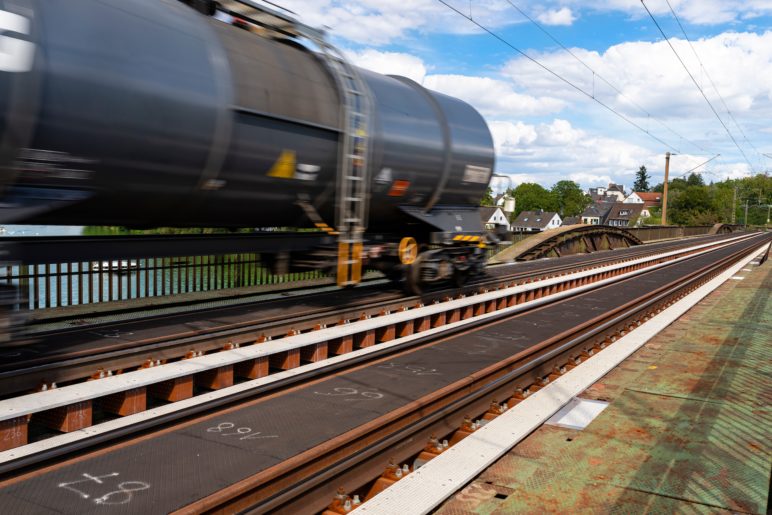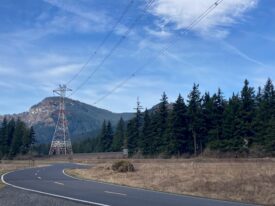It’s been seven years since a runaway train jumped its tracks in a Canadian town, erupted into flames, spilled millions of gallons of oil near the Chaudière River, and killed 47 people.
The disaster in Lac-Mégantic, Quebec, is one of dozens of oil train derailments that give environmental and public safety advocates reason to object to the Trump’s administration’s new rule that allows rail shipments of liquefied natural gas (LNG), a substance far more hazardous than crude oil. The US Pipeline and Hazardous Materials Safety Administration published this rule despite criticisms of the lack of safeguards. Two separate lawsuits filed last month—one by 15 states, including Washington and Oregon, and the other by six environmental protection groups—challenged federal agencies over the rule, which took effect in August and allows railroads to transport LNG in tank cars nationwide. Last year Trump issued an executive order that directed federal agencies to speed up oil and gas pipeline projects and allow the LNG rail shipments.
The Trump administration’s decision is one that rail companies have wanted for years. Among these companies are Union Pacific and BNSF, the dominant railways in Oregon and Washington responsible for several hazardous derailments in the past decade alone. One of the worst was Union Pacific’s 11-car derailment in Mosier, Oregon that resulted in a fiery explosion and an oil spill along the Columbia River in 2016. BNSF is responsible for its own oil train conflagrations too, including two North Dakota explosions that prompted towns to evacuate in 2013 and 2015, and a derailment in Illinois in 2015.
A high-speed derailment and spill could have “catastrophic consequences,” Bradley Marshall of EarthJustice said. “It won’t take much LNG to infiltrate and potentially blow up a city.”

Bradley Marshall, an Earthjustice attorney representing the environmental groups in the complaint, said that the rule was a way to transport massive amounts of LNG while bypassing pipeline regulations. For years activists and Native American tribes have been fighting major LNG projects, including Tacoma’s LNG plant and the Jordan Cove LNG export facility in Coos Bay, Oregon. These new fossil fuel projects depend on gas deliveries and are struggling to expand supply pipelines as they increasingly face tough regulatory battles with surrounding communities and governments overseeing the projects. For these projects, the ability to transport LNG by rail could be a partial or temporary solution to more permanent pipeline developments.
But the temporary measure carries serious risk that is drawing opposition from state and local elected officials. The governors of both Oregon and Washington have been outspoken in opposing the new rule. Washington governor Jay Inslee criticized the feds for the lack of an “adequate review” and said that such a move poses a significant risk for public safety. Spokane City Council president Breean Beggs told the Spokesman Review that the council may discuss LNG rail shipments because the city has elevated train tracks running through its downtown core, which could present a serious public safety risk in the event of a derailment. Environmental advocates in the Pacific Northwest have been pushing to resist shipments of fossil fuels, prompting more local governments, such as those of King County and Portland, to enact their own legislation limiting new gas infrastructure.
LNG is highly flammable in the case of a spill and, in the event of a tank car rupture, much more explosive than crude oil. A 2014 explosion at a small LNG plant in Eastern Washington caused $69 million in damages, injured five employees, and prompted evacuation of hundreds of homes. It is just one prominent example of the risks involved. Four of the 14 employees at the LNG facility were injured by flying debris, and one was hospitalized for burns. And hours after equipment in the facility exploded, 14.3 million cubic feet of gas leaked from a storage tank, forming a highly explosive vapor cloud that drifted toward the town of Plymouth in Benton County.
Nevertheless, the US Pipeline and Hazardous Materials Safety Administration and US Department of Transportation implemented the Trump administration’s new rule months before the Federal Railroad Administration (FRA) was expected to release a study on the safety of the tank cars that would be used to transport the fuel. The new rule raises the stakes by allowing shipments nationwide, which means carrying the explosive material from shale fields to port cities for export. Compounding the risk, there are few standards in place that require corporations to publicly disclose information that would hold them accountable for problems that arise or financial impacts of spills.
Rail companies and environmental whistleblowers alike have kept a close eye on trial projects in Florida and Alaska, where the FRA allowed small amounts of LNG to be transported through railways with special permits since 2015. The Trump administration also more recently issued special permits for LNG rail shipments in Pennsylvania and New Jersey—two states involved in the lawsuit. But little information is publicly available about the impact these projects have had.
“LNG is prohibited to be transported by rail for a reason,” said Emily Jeffers, an attorney for the Center for Biological Diversity, one of the groups suing federal agencies.
US Transportation Secretary Elaine Chao argues that the rule “carefully lays out key operational safeguards” while allowing LNG to be transported in more parts of the country “where this energy source is needed.”
Although the rule requires LNG to be shipped using a type of tank car with a thicker outer shell made of steel, environmental advocates say it is still too risky. And environmental litigants believe that the Trump administration has not properly followed the rulemaking process nor fully explained the environmental impact of its decision.
A high-speed derailment and spill could have “catastrophic consequences,” Marshall said. “It won’t take much LNG to infiltrate and potentially blow up a city.”
Sightline Institute is a 501(c)3 non-profit organization and does not support, endorse, or oppose any candidate or political party.
Hayat Norimine, research contributor, is a freelance writer who grew up in Washington on the border of Idaho. She previously covered city halls and politics for The Dallas Morning News, Seattle Met magazine, and The Daily News in Longview, Washington. She has an MA in journalism from the Medill School of Journalism and a BA in English from the University of Washington. For Sightline, she researches and writes about democracy reform and elections issues and reports on fossil fuel proposals along the Thin Green Line.











RenfeMikado
That’s a German tank car in the accompanying photo; not a North American LPG tank car. (for what it’s worth…)
Susan Price
Trains pulling LNG tank cars should not pass thru cities and towns. Would the state allow a car full of dynamite pass thru a densely populated area? LNG tank car and a car carrying dynamite = potential bombs. How far does a freight line track pass near your house?